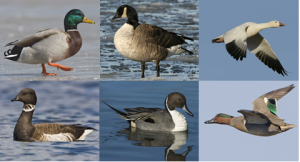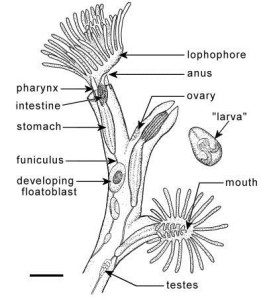
Facebook Twitter Instagram YouTube
Written on: December 1st, 2018 in Wetland Animals
By Kenny Smith, DNREC’s Wetland Monitoring and Assessment Program
Wetlands provide many services to us, like purifying our water, flood protection, and wildlife habitat. The animals that live in our wetlands can provide ample opportunities for outdoor activities like bird watching, fishing, and hunting. Delaware’s typical hunting and trapping seasons start in September and concludes at the end of January. Some of these species are migrants and pass through our wetlands on their way to wintering or breeding grounds, but most of these species are year round residents. Continue on to learn about some of the hunting and trapping that you can do in the wetlands of Delaware and potentially partake if these opportunities seem interesting to you.
Waterfowl
Starting with the most common hunting activity in our wetlands is waterfowl hunting, this consists of ducks, Canada geese, snow geese, and brant. These species use a diverse array of wetlands in the state from tidal wetlands to wooded depression wetlands. Wood ducks prefer non tidal wooded wetlands where they can nest in tree cavities, while snow geese will roost along tidal wetlands on their way to wintering areas.

Most of the waterfowl hunting in Delaware is focused on the winter migrations of these birds, they leave the arctic breeding grounds and fly through Delaware on the way to wintering grounds in the southern U.S. Based on Delaware Fish and Wildlife mail surveys, the estimated harvest of ducks last year was just over 40,000 while Canada geese harvest was about 20,000, and snow geese was 11,000. This survey estimates that around 5,000 people enjoy waterfowl hunting in the states wetlands every year.
Muskrat
Muskrat are a year round resident of tidal salt marshes throughout the state, they create small mounds in salt marshes where they live. Muskrat are members of the rodent family but are actually omnivores and will consume vegetation but also frogs and fish.
They are one of the more common species to be trapped in Delaware and have been a Delaware tradition since colonization, with the meat and fur being the objective. The furs are sought after for clothing manufacturing, mostly in China, Russia, and Korea now that the North American fur demand has decreased significantly.
The meat from muskrat is a local delicacy and is often sold to local restaurants, local wild game dinners, or consumed by the trapper. If you are daring, some Delaware restaurants still serve muskrat and it can still be found at local butcher shops.
Non-waterfowl Gamebirds
The non-waterfowl gamebirds I am referring to are the rails, snipe, coot, and the gallinules and moorhens. Most of these birds migrate through Delaware, with rails being the exception being year round residents. Rails are a secretive marsh bird that inhabits our tidal salt marshes, with 4 different species being the target of sportsmen. The clapper rail is the most common rail found in Delaware, with the sora, the Virginia rail, and the King rail being the least common. Snipe are the next bird that hunters can target, and this is not a childhood prank. Snipe are actually a very common bird that hunters pursue. These birds usually can be found around open marshes and mud flats of our coastal wetlands. In the Delaware Fish and Wildlife mail surveys, they estimated that almost 400 rail and about 40 snipe were hunted last year.
Coots, gallinules, and moorhens are not as regional hunted as they are in other parts of the country but we do have them and they legally can be harvested. Coots can be found along marsh edges and can create large flocks on open water while moorhens and gallinules are more solitary and can be found along edges of marshes or ponds similar to rails.
Bullfrog and Snapping Turtles
Bullfrog and Snapping turtles are year round residents and can be found in many of our freshwater wetlands throughout the state. Bullfrog hunting is slightly different from any other hunting that happens in wetlands, you are allowed to do it at night, you don’t use a trap or gun, and the frog season runs from May 1st to September 30th. Instead you can use a light at night in the warmer months and hunt frogs with a spear or gig. Bullfrog hunting is very common in the southern U.S., and is still practiced by many in the Delmarva region. Bullfrog hunting can be a very inexpensive hunting endeavor since only a light and gig are required once you have the proper license.
On the flip side snapping turtle trapping is a very labor intensive adventure and you will need a lot more equipment. You can still try and use a spear, gig, or net but it is usually not as successful as using traps. The snapping turtle season runs from June 15th to May 15th and each turtle has to be a minimum of 11 inches on the curvature of the top shell. Bullfrog and snapping turtle are the 2 most common herpetological prey for hunters to pursue and are abundant throughout the state.
Highlighted were just some of the opportunities to hunt or trap in the wetlands of Delaware, check the Delaware Hunting guide for the proper seasons and laws before partaking in these activities. You will need to purchase a hunting or trapping license and tag along with a friend or family member and enjoy the outdoors. Below are some online resources to help you if you would like to try hunting or trapping in Delaware.
Written on: December 1st, 2018 in Wetland Animals
By William Koth, DNREC’s Delaware State Parks
Bryozoans may be one of our most overlooked and underappreciated animals. Known as “Moss Animals,” bryozoans are small, simple animals rarely growing more than 1/25th of an inch in length. However, most bryozoans form colonies that can vary greatly in number, form, and size.
Bryozoan Biology
Each individual animal, or zooid, has a simple body style, usually round or oval in shape with a single opening that serves as both a mouth and an anus. Bryozoans lack any respiratory, excretory,or circulatory systems, but have a central nerve ganglion that allows the animal to respond to stimuli. They feed using small tiny ciliated (hair-like) tentacles that the surround the opening and push food through the it into the gut. In some species, and during certain life periods, these tentacles can be used for simple movement. Most species, however, spend the majority or all of their lifespan immobile.
How Many Kinds are There?
The vast majority of Bryozoan species are marine animals. Of nearly 5,000 species, less than 90 have been identified in freshwater environments, and only 24 freshwater species in North America (so far). In the freshwaters of Delaware, you are most likely to encounter the native Magnificent Bryozoan (Pectinatella magnifica). This colonial species forms jelly-like “green blobs” on underwater vegetation, branches and other structures. They may also form free floating round colonies. The small visible rosettes on the surface of the colony are groups of 12-18 individual animals.
How Do They Reproduce?
Although the Magnificent Bryozoan reproduces both sexually and asexually, the main way the colonies form is when the existing individual animal or zooid breaks away or buds asexually forming a twin. As they reproduce, they multiply into an ever growing sphere as the individuals point their mouths outwards to take advantage of available food. Meanwhile, the zooids excrete gelatinous material to give the sphere interior support.
Completely new colonies can also form asexually from small statoblasts (a group of cells encased in a hard covering to protect them from freezing or other harsh conditions). These statoblasts can float in the current, or settle to the bottom where they eventually grow into an individual zooid. These individual zooids can use their ciliated tentacles to move about in the water. They will eventually begin dividing and form a new colony. Smaller free floating colonies have been observed to use the ciliated tentacles in unison to move toward or away from stimuli.
What Do They Eat?
The Magnificent Bryozoan actively feeds on suspended organic material, zooplankton, and algae. In this way it can be considered a filter feeder and may, in some instances, increase water clarity. Individual animals on the colony are clear or opaque. It is speculated that the green color of the colonies stems from ingested algae.
Native or Invasive?
The Magnificent Bryozoan is native to Delaware, its native range extends from the Mississippi eastward to the Atlantic Coast from Ontario southward to Florida. Invasive outbreaks have been occurring in Europe since the 1930’s and west of the Mississippi since the 1950’s. The ecological impact of these invasions is still being studied, but colonies and groups of colonies have started to block some smaller waterways, ditches, and drainpipes. Colonies have been recorded up to 4 feet in Virginia, although the typical size found in Sussex County swamps, ponds and waterways is an inch to about a foot in diameter.

Encountering a colony of these animals can be a great experience. Trap Pond State Park staff receive several inquiries about these creatures each year. Most folks guess that they are some type of algae or fungus. Other guesses include freshwater jellyfish or fish eggs. Almost everyone is surprised to find out it is actually a colony of animals.
The staff recommend that you take full advantage of discovering one of these unique creatures. They do request that you not dislodge attached colonies, and not to keep them out of the water for more than a few minutes at a time. Lift it up, feel its surface, feel its weight, smell it. If you have a magnifying glass, take a look at the individual zooids on the surface. They are amazing animals that deserve a closer look and a little more appreciation!